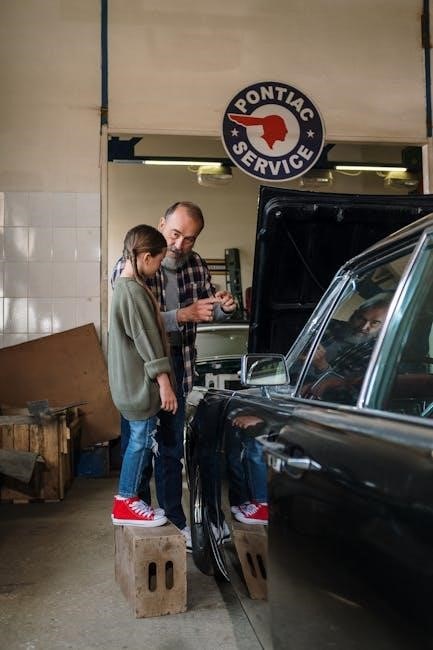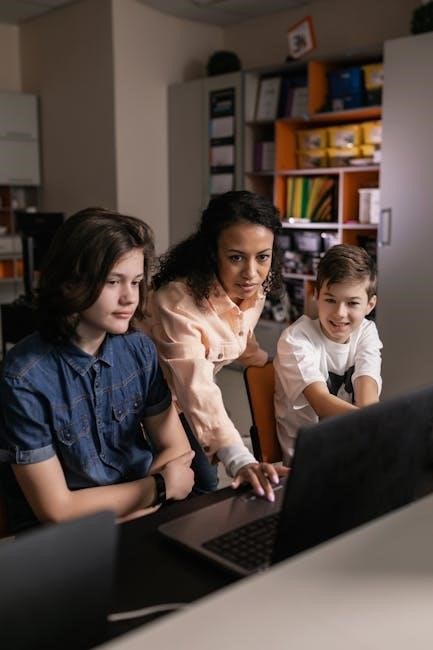Trick-or-treating is a popular Halloween activity where children dress up in costumes and visit neighbors to collect candy and other treats, promoting fun and community interaction.

1.1 What is Trick-or-Treating?
Trick-or-treating is a Halloween tradition where children dressed in costumes visit neighbors to ask for candy or small treats. The phrase “trick or treat” implies a playful request, with the understanding that a treat is expected. This activity is a cornerstone of Halloween celebrations, fostering fun and community interaction. While its origins are debated, it is believed to stem from ancient festivals and practices. Today, it is a beloved ritual, allowing children to enjoy imaginative costumes and collect sweets while connecting with their community. Parents often accompany younger children to ensure safety. The tradition emphasizes both excitement and responsibility, making it a memorable experience for participants of all ages.
1.2 Brief History and Cultural Significance
Trick-or-treating has roots in ancient festivals, such as the Celtic harvest festival Samhain, where people would disguise themselves and ask for food or other offerings. The tradition evolved through the Christian celebration of All Souls’ Day, where poor individuals would receive soul cakes in exchange for prayers. In the United States, trick-or-treating gained popularity in the early 20th century as a fun and safe activity for children. It has since become a cultural phenomenon, symbolizing community bonding and creativity. The practice reflects a blend of traditions, highlighting its enduring appeal as a family-friendly event. Its cultural significance lies in its ability to bring people together and celebrate shared customs.

Pre-Trick-or-Treat Instructions
Plan your route, choose a safe costume, and ensure adult supervision for young children. Prepare flashlights and bags for collecting treats. Stay alert and visible.
2.1 Planning the Route
Planning the trick-or-treat route is essential for a smooth and enjoyable experience; Parents should map out neighborhoods with well-lit streets and friendly homes. Avoid areas with heavy traffic or poorly lit sidewalks. Identify homes likely to participate by checking for porch lights or Halloween decorations. Set a time limit to ensure kids don’t stay out too late. Consider the age and endurance of children when deciding how many houses to visit. Discuss the route with kids beforehand to set expectations. Adults should accompany younger children, while older kids may go in groups with agreed-upon boundaries. Always carry a phone for emergencies and ensure everyone knows the route. This preparation helps ensure safety and fun for all.
2.2 Choosing the Right Costume
Choosing the right costume is a fun and important part of trick-or-treating. Kids should pick costumes that reflect their interests or favorite characters, ensuring they are comfortable and safe. Avoid masks or headgear that obstruct vision, and opt for lightweight, breathable fabrics. Costumes should be flame-resistant to minimize risks. Add reflective tape or glow-in-the-dark accents for better visibility at night. Weather-appropriate layers, like a coat or rain jacket, should be considered. Parents should supervise young children in selecting costumes to ensure safety and appropriateness. Finally, check costumes for any small parts or allergens that could pose a hazard. The right costume enhances the Halloween experience while keeping kids safe.
2.3 Safety Precautions for Parents and Kids
Safety is crucial for a fun and worry-free Halloween. Parents should always accompany young children, ensuring they stay within familiar neighborhoods. Teach kids to cross streets safely and avoid dark or unlit areas. Reflective costumes or accessories can increase visibility. Carry a flashlight to light the way and be seen by others; After collecting treats, inspect all candy for tampering before allowing consumption. Avoid unwrapped or suspicious items. Planning the route in advance helps avoid unknown areas, and staying in groups adds an extra layer of safety. By following these guidelines, parents and kids can enjoy a safe and enjoyable trick-or-treating experience. This ensures everyone has a memorable and secure Halloween night.
Good manners are essential while trick-or-treating. Always say “trick or treat” politely and thank the giver. Respect homes by not damaging property or being disruptive. Saying “Trick or Treat” politely is a cornerstone of Halloween etiquette. When approaching a door, children should greet the homeowner with a cheerful “Trick or Treat!” This simple phrase not only shows respect but also sets a positive tone for the interaction. It’s important to speak clearly and with a smile, making sure the homeowner feels appreciated for their participation. Parents should remind their kids to avoid shouting or being aggressive, as this can create a negative impression. By teaching children to express gratitude with a polite “thank you” after receiving candy, parents help instill good manners and ensure a pleasant experience for everyone involved. Respecting neighborhood rules is essential for a positive Trick-or-Treat experience. Always stay on designated pathways, avoid trespassing, and never enter homes unless explicitly invited. Be mindful of signs indicating houses that do not participate, such as porch lights being off. Respect noise levels, especially in quiet neighborhoods, and avoid damaging property. Teach children to stay in groups and follow adult guidance. If a house has specific rules, such as taking only one piece of candy, ensure kids adhere to them. Respect cultural differences and traditions within the community. By being courteous and considerate, trick-or-treaters can help maintain a safe and enjoyable environment for everyone. Parents should lead by example, reinforcing these principles before heading out. Avoiding vandalism and disrespectful behavior is crucial during Trick-or-Treating. Ensure children understand that damaging property, such as knocking over decorations or littering, is unacceptable. Teach them to stay on designated pathways and avoid entering private areas without permission. Vandalism not only harms others but also reflects poorly on the community. Parents should emphasize the importance of respecting others’ property and the consequences of harmful actions. Encourage kids to focus on collecting treats and enjoying the festive atmosphere rather than engaging in disruptive behavior. Remind them to dispose of trash properly and avoid pranks that could cause harm. By promoting responsible behavior, Trick-or-Treaters can help maintain a positive and safe experience for everyone involved. After collecting treats, sort and inspect candy. Discard unwrapped or suspicious items. Parents should check for safety and ensure hygiene. After trick-or-treating, children should immediately sort and inspect their candy. Parents should assist in checking each treat for any signs of tampering or damage. All unwrapped candies or those with open packaging should be discarded to ensure safety. It’s important to teach kids to avoid consuming any treats that look suspicious or unfamiliar. This step helps prevent potential health risks and ensures a safe Halloween experience. Always prioritize caution and maintain a routine of careful inspection to protect children from harm. By taking these precautions, families can enjoy the treats they’ve collected while staying safe. Parents and children must avoid unwrapped or suspicious items while sorting Halloween candy. Teach kids to recognize signs of tampering, such as torn wrappers, open packages, or items that look unusual; Emphasize the importance of not eating any treats before they are thoroughly checked at home. Discard any candy that appears altered or unfamiliar to ensure safety. This precaution helps prevent potential health risks and maintains a fun, secure Halloween experience. Always prioritize caution and educate children on the dangers of consuming unverified treats. By adhering to these guidelines, families can enjoy their Halloween haul without worrying about safety issues. Explore community events, parties, or non-candy options for a fun Halloween experience, ensuring all participants enjoy the festivities safely and inclusively. Community events and parties offer a fantastic alternative to traditional trick-or-treating, providing a safe and festive environment for kids and families. Many schools, libraries, and local organizations host Halloween-themed events, featuring costume contests, games, and haunted houses. These gatherings often include music, crafts, and spooky decorations, creating an engaging atmosphere for all ages. Additionally, some neighborhoods organize trunk-or-treat events, where families decorate their car trunks and distribute candy in a controlled setting. These events not only ensure safety but also foster a sense of community. Parents can enjoy peace of mind while their children have fun in a supervised environment. Such events are perfect for those seeking a trick-or-treat alternative that still captures the spirit of Halloween. For those seeking alternatives to candy, non-candy treats are a great option, especially for children with dietary restrictions or preferences. Stickers, small toys, and trinkets are popular choices that bring joy without the sugar. Glow sticks or temporary tattoos can add a fun twist while also promoting visibility during evening trick-or-treating. These options are widely available and can be purchased in bulk, making them convenient for handing out to multiple children. Offering non-candy treats is also a thoughtful way to accommodate kids with allergies or those who prefer non-edible items. This approach helps reduce sugar intake while still keeping the spirit of the tradition alive. Parents and organizers can consider these alternatives to ensure all children feel included and happy. Trick-or-treating is a delightful Halloween tradition that combines fun, safety, and community spirit. By following these guidelines, everyone can enjoy a memorable and joyful experience. To ensure a fun and safe trick-or-treating experience, always plan a route in advance and stick to well-lit, familiar neighborhoods. Children should be accompanied by adults, especially after dark. Costumes should be visible and not obstruct vision or movement. Carry a flashlight or glowstick to enhance visibility. Teach children to say “Trick or Treat” politely and thank each homeowner. Avoid entering homes or taking unwrapped candies. Check all treats before consumption. Respect others’ property and follow local rules. These tips help create a memorable and enjoyable Halloween for everyone involved. Stay safe, be courteous, and have fun!
Trick-or-Treat Etiquette
3.1 Saying “Trick or Treat” Politely
3.2 Respecting Neighborhood Rules
3.4 Avoiding Vandalism and Disrespectful Behavior
Handling Candy and Treats
4.1 Sorting and Inspecting Candy
4.2 Avoiding Unwrapped or Suspicious Items
Alternative Activities for Trick-or-Treaters
5.1 Community Events and Parties
5.2 Non-Candy Treat Options

6.1 Final Tips for a Fun and Safe Experience
